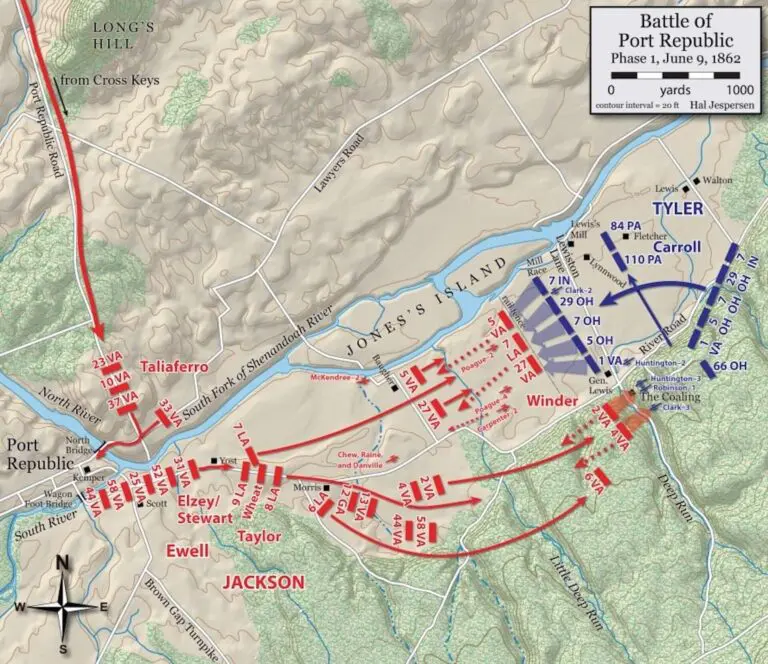Located three miles east of Port Republic in Rockingham County, Virginia, the Port Republic battlefield retains many Civil War-era features. The battle that took place here on June 9, 1862, proved to be a bloody affair, with almost two thousand casualties.
The Battle of Port Republic was the final battle in Jackson’s Valley Campaign. It was a decisive victory for the Confederates, allowing Stonewall Jackson’s troops to reinforce Robert E. Lee before Richmond in the Seven Days Battles.
The fierce battle of Port Republic took place on June 9, 1862. Stonewall Jackson and his army had been pursued south along the Shenandoah Valley by two sets of Union forces. Unwilling to let the larger Union army group at Port Republic, Jackson had taken the fight to them.
On June 8, under Gen. Ewell’s command, Confederate troops had successfully repelled Frémont’s army at the battle of Cross Keys. Now it was Jackson’s turn to engage the Federals in battle.
Jackson aimed to attack the Union brigades of Gen. James Shields (though Gen. Erastus Tyler was commanding them on the field), hoping that he would be victorious through sheer numbers alone.
However, getting his troops together at Port Republic was more difficult than he thought, and he began the fight outnumbered.
The Union forces also had a geographical advantage. Their left flank was stationed on a hill known locally as The Coaling and the right flank was anchored on the Shenandoah River. With his infantry in such a good position and covered by 16 artillery guns, Tyler would not be easy to defeat.
The brigades of Generals Winder and Ewell were the first to advance on the Union army but quickly came under heavy fire.
Winder’s men were pinned down on the Union’s right flank and Ewell, who had tried to approach from the open plain, had to order his men to find cover.
However, Jackson knew that ultimate victory all depended upon taking The Coaling. He sent in Richard Taylor’s brigade (including the famed Louisiana Tigers). They swarmed the Union’s guns, and bloody hand-to-hand combat ensued.
Initial success was met with Shields’ men re-taking their original positions. But the Confederates could take control of five heavy guns and turn this firepower on the Union forces.
At this point, the Confederates took control of The Coaling, and Jackson was able to implement a general advance.
The Union’s Gen. Erastus Tyler was forced to withdraw his troops from the field. Although Union reinforcements had arrived under the leadership of Frémont, it was no use. Ewell had burned the last remaining bridges across the Shenandoah River, meaning the Union army faced too many obstacles to be able to mount another counterattack.
Though the day had not gone according to initial plans, the Confederates had secured their victory, and Jackson’s Valley Campaign was complete.
In the end, the Union’s casualties numbered 1,002, while Confederate casualties totaled 816 — another reminder of the viciousness of this war.
Continue exploring the history of the American Civil War in Virginia with more of our Virginia Civil War Battlefield Guides.

Ready to explore the battlefield for yourself? Browse our full selection of American Civil War Battlefield Tours.
Please contact us if you have any questions about our tours or services.